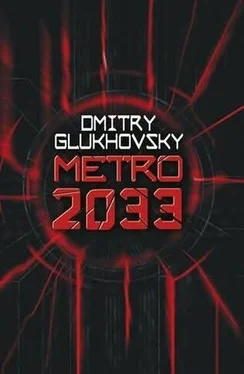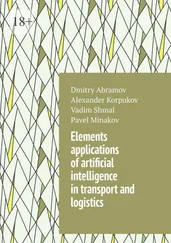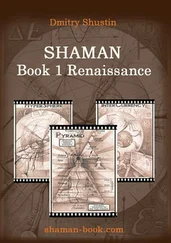‘What’s next? Prospect Mir station. Well, and it makes sense that it’s Prospect Mir. That’s the boundary of the Hanseatic League. My stepfather says that everything’s still the same between the Hansa and the Reds – they’ve kept the peace. No one there gives a thought to the war anymore,’ said Artyom.
‘The Hanseatic League ’ was the name of the ‘Concord of Ring Line Stations.’ These stations were located at the intersection of all the other lines, and, therefore of all the trade routes. The lines were linked to one another by tunnels, which became a meeting place for businessmen from all over the metro. These businessmen grew rich with fantastic speed, and soon, knowing that their wealth was arousing the envy of too many, they decided to join forces. The official name was too unwieldy though, and among the people, the Concord was nicknamed the ‘Hansa’ (someone had once accurately compared them to the union of trade cities in Medieval Germany). The short word was catchy, and it stuck. At the beginning, the Hansa consisted of only a few stations; the Concord only came together gradually. The part of the Ring from Kievskaya to Prospect Mir, what’s called the Northern Arc, and that included Kurskaya, Taganskaya and Oktyabrskaya. Then Paveletskaya and Dobrynskaya joined in and formed another Arc, the Southern Arc. But the biggest problem and the biggest hindrance to uniting the Northern and Southern Arcs was the Sokol Line.
The thing was, Artyom’s stepfather told him, the Sokol line was always sort of special. When you glance at the map, your attention is immediately drawn to it. First of all, it’s a straight line, straight as an arrow. Secondly, it was marked in bright red on metro maps. And its station names contributed too: Krasnoselskaya, Krasne Vorota, Komsomolskaya, Biblioteka imena Lenina and Leninskie Gori. And whether it was because of these names or because of something else, the line would draw to itself everyone who was nostalgic for the glorious Soviet past. The idea of a resurrection of the Soviet state took easily there. At first, just one station returned to communist ideals and a socialist form of rule, and then the one next to it, and then people from the tunnel on the other side caught wind of this optimistic revolution and chucked out their administration and so on and so on. The veterans who were still alive, former Komsomol men and Party officials, permanent members of the proletariat – they all came together at the revolutionary stations. They founded a committee, responsible for the dissemination of this new revolution and its communist idea throughout the metro system, under the almost Lenin-era name of ‘Interstational.’ It prepared divisions of professional revolutionaries and propagandists and sent them to enemy stations. In general, little blood was spilt since the starving inhabitants of the Sokol line were thirsting for the restoration of justice, for which, as far as they understood, apart from unjustified egalitarianism, there was no other option. So the whole branch, having flared up at one end, was soon engulfed by the crimson flames of revolution. The stations returned to their old, Soviet names: Chistye Prudy became Kirovskaya again; Lubyanka became Dzerzhinskaya; Okhotnyi Ryad became Prospect Marx. The stations with neutral names were renamed with something more ideologically clear: Sportivnaya became Kommunisticheskaya; Sokolniki became Stalinskaya; Preobrazhenskaya Ploshchhad where it all began, became Znamya Revolutsya. And the line itself, once Sokol, was now called by most the ‘Red Line’ – it was usual in the old days for Muscovites to call their metro lines by their colours on the map anyway, but now the line was officially called the ‘Red Line.’
But it didn’t go any further.
When the Red Line had formed itself and had ideas about spreading itself through the metro, patience quickly wore thin at other stations. Too many people remembered the Soviet era. Too many people saw the agitators that were sent by the Interstational throughout the metro as a tumour that was metastasising, threatening to kill the whole organism. And as much as the agitators and propagandists promised electricity for the whole metro, that by joining with the Soviet powers they would experience real communism (it was unlikely that this had come from any actual slogan of Lenin’s – it was so exploitative), people beyond their boundaries weren’t tempted. The Interstational sloganeers were caught and thrown back to their Soviet territory. Then the Red leadership decided that it was time to act more resolutely: if the rest of the metro wouldn’t take up the merry revolution flame then they needed to be lit from underneath. Neighbouring stations, worried about the strengthening communist propaganda, also came to the same conclusion. Historical experience demonstrates well that there isn’t a better way of injecting communist bacilli into an area than with a bayonet.
And the thunder rumbled.
The coalition of anti-communist stations, directed by the Hansa, broke the Red Line and wanting to close the Ring circle took up the call. The Reds, of course, didn’t expect the organized resistance and overestimated their own strength. The easy victory they had anticipated couldn’t even be seen in their distant future. The war turned out to be long and bloody, wearing on and on – meanwhile, the population of the metro wasn’t all that large… It went on for almost a year and a half and mostly consisted of battles for position involving guerrilla excursions and diversions, the barricading of tunnels, the execution of prisoners, and several other atrocities committed by either side. All sorts of things happened: Army operations, encirclement, the breaking of encirclement, various feats, there were commanders, heroes and traitors. But the main feature of this war was that neither of belligerent parties could shift the front line any considerable distance.
Sometimes, it seemed that one side was gaining an edge, would take over an adjacent station, but their opponent resisted, mobilized additional forces – and the scales were tipped to the other side.
But the war exhausted resources. The war eliminated the best people. The war was generally exhausting. And those that survived grew tired of it. The revolutionary government had subtly replaced their initial problems with more modest ones. In the beginning, they strove for the distribution of socialist power and communistic ideas throughout the underground but now the Reds only wanted to have control over what they saw as the inner sanctum: the station called Revolution Square. Firstly, because of its name and secondly because it was closer than the any other station in the metro to the Red Square and to the Kremlin, the towers of which were still adorned with ruby stars if you believed the brave men who were so ideologically strong that they broke the surface just to look at them. But, of course, there at the surface, near the Kremlin, right in the centre of the Red Square was the Mausoleum. Whether Lenin’s body was still there or not, no one knew, but that didn’t really matter. For the many years of the Soviet era, the mausoleum had ceased to be a tomb and had become its own shrine, a sacred symbol of the continuity of power.
Great leaders of the past started their parades there. Current leaders aspired to it. Also, they say that from the offices of the Revolution Square station there are secret passages to the covert laboratories of the mausoleum, which lead directly to the coffin itself.
The Reds still had Prospect Marx, formerly Okhotnyi Ryad, which was fortified and had become a base from which attacks on Revolution Square were launched. More than one crusade was blessed by the revolutionary leadership and sent to liberate this station and its tomb. But its defenders also understood what meaning it held for the Reds and they stood to the last. Revolution Square had turned into an unapproachable fortress. The most severe and bloody fights took place at the approach to the station. The biggest number of people was killed there. There were plenty of heroics, those that faced bullets with their chests, and brave men who tied grenades to themselves to blow themselves up together with an enemy artillery point, and those that used forbidden flame-throwers against people… Everything was in vain. They recaptured the station for a day but didn’t manage to fortify it, and they were defeated, retreating the next day when the coalition came back with a counterattack.
Читать дальше











